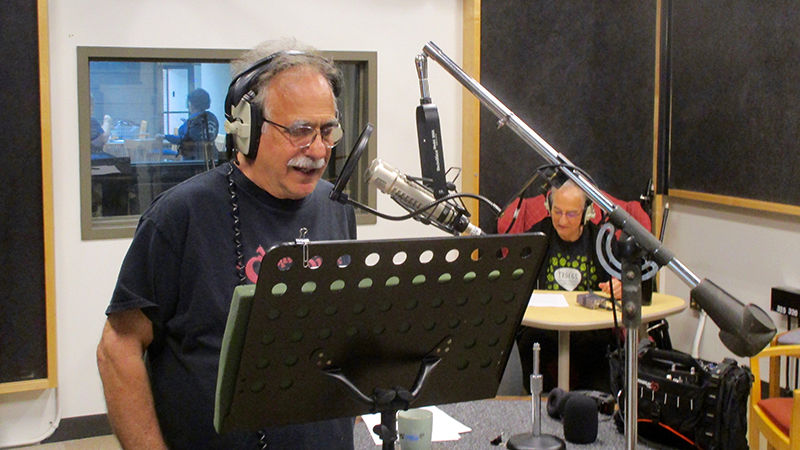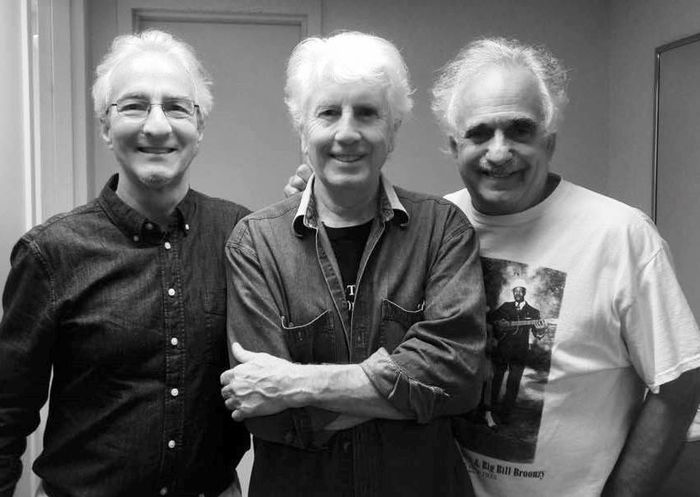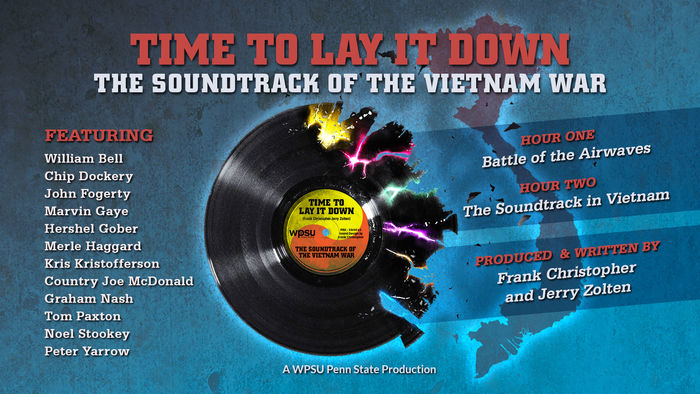

This dialog contains the full navigation menu for this site.

Jerry Zolten stands at a microphone in the WPSU studios, headphones on and script in hand. Producer Frank Christopher sits at a nearby table, also in headphones and with the same script. They’re recording the narration for their radio program, Time to Lay It Down: The Soundtrack of the Vietnam War.
Zolten: “As cynicism grew in the ranks the soundtrack became a barometer of shifting attitudes.”
Christopher: It sounds like you’re reading.
Zolten: “As cynicism grew in the ranks the soundtrack became a barometer of shifting attitudes.”
Christopher: Don’t hit the “b” sound so hard. Back it up.
Zolten: “As cynicism grew in the ranks the soundtrack became a barometer of shifting attitudes.”
And on it goes. Although they have already written the script, while they record they edit as they go—taking out a word, changing another, listening to the way it sounds and altering as necessary. And this is after Christopher took the original written script and recorded it with his own voice to test sound and content. Tedious work but necessary for a quality final product. The recordings will then be inserted into the radio program, among the interviews and music.
Zolten, associate professor of communication arts and sciences and integrative arts at Penn State Altoona, and Academy Award–nominated film producer Frank Christopher collaborated on Time to Lay It Down: The Soundtrack of the Vietnam War, a two-part radio program that premiered in early September just before The Vietnam War, the 10-part documentary by Ken Burns and Lynn Novick, aired on television.
Part 1 of the radio show, “The Battle of the Airwaves,” “deals with the soundtrack heard here [the United States],” Zolten says. “Technically US involvement starts in 1959, but it picks up around ’64–65—and in the music you hear the growing awareness and the different attitudes, the fractures that divided our society. There was a battle of songs going on.” In addition to the songs themselves, “we’ve got the voices of many of those who made the music. Pre-existing recordings of artists no longer alive like Jimi Hendrix, Marvin Gaye, and Merle Haggard. But we also talked to a number of artists—Peter and Paul of Peter, Paul, and Mary, Country Joe McDonald, soul singer William Bell, Graham Nash of Crosby, Stills, & Nash, to name a very few, along with many Vietnam veterans and experts on the music of the era.”

Producers Frank Christopher (left) and Jerry Zolten (right) with Graham Nash
Music listeners may think they know all the songs of the era that reflected the war. But, as Christopher says, “We live in bubbles. We didn’t know country or blues.” Research for the program expanded musical knowledge for both men. Christopher admits, “Some of my favorite songs [in the program] are not rock-n-roll.”
The songs chosen also are not necessarily what we know as “hits.” Part 2 of the program, “The Soundtrack in Vietnam,” approaches the music from an unfamiliar perspective to those who didn’t serve in that war. Zolten says it “speaks to what the music meant to troops in Vietnam. Location meant everything and to a GI in Vietnam, a song like the Animals’ ‘We Gotta Get Out of This Place’ took on a whole other meaning in Vietnam.” The program also includes songs that were “bootlegged” in, “forbidden by the military brass because they were ‘demoralizing’ or had drug references. There are also songs that were written and recorded by troops in the field that reflect their attitudes and helped them survive.”
Beyond some famous events and what are now iconic pictures, much of the history of the war in Vietnam is unfamiliar to the general public. Some of the people making efforts to end the conflict peacefully were doing it in Vietnam. “General [Edward] Lansdale [USAF] saw the war as not winnable by military force,” Christopher says. “When you’re fighting alongside the Vietnamese, it’s critical to understand what motivates them, and learning their songs is a key to achieving understanding. They have a spirit that’s captured in music that they can cling to and fight for that. So [Lansdale] pulled together these people like Herschel Gober [a soldier and musician], and Vietnamese poets and singers, and he would have these sessions in his living room recorded.”
Lansdale saw a broader use to those recordings than just bringing people together. Christopher says, “He packaged and sent them to President Johnson, Secretary of Defense Robert McNamara, and Secretary of State Dean Rusk to give LBJ context for his decisions about the strategy for Vietnam based on more than on body counts, but on the aspirations of the Vietnamese people.”
Zolten and Christopher were assisted by a summer intern, Dante DiAndrea, who is a junior majoring in film at Ithaca College. “In the summer it’s the people who have dedication and skills [who intern],” Christopher notes. “Dante has real talent.” It was “his intensity, curiosity, and can-do spirit” that got him the job working on Time to Lay It Down.
DiAndrea appreciates the opportunity he was given as well as the history lesson. “I am so fortunate to be able to help preserve and retell a history that still affects us to this day.” His work responsibilities varied from “general assistant editing tasks such as organizing media and making sure the audio files were the highest quality we could get our hands on,” to the larger work of “editing of the project itself, including the building of assembly cuts of both programs and more nuanced edits that brought us closer to the final cuts of the programs.” He “also wrote and produced three 30-second promos to help promote the program on PRX, an Internet radio distribution platform.” When DiAndrea says, “I learned so much,” Zolten adds, “It was a tremendous learning experience for us all.”
Time to Lay It Down: The Soundtrack of the Vietnam War debuted on WHYY-FM Philadelphia on September 3 and 10. It will air on WPSU on September 16 from noon - 2:00 p.m. On September 20 at noon Zolten will join musicologist Hugo Keesing, one of the experts heard in the radio program and the compiler of the definitive collection of Vietnam era songs, Next Stop is Vietnam/The War on Record (Bearsville) for a Common Read event, “War and Conflict: Tribal Songs,” in Misciagna’s Titelman Lounge.

Artwork for Time to Lay it Down: The Soundtrack of the Vietnam War


